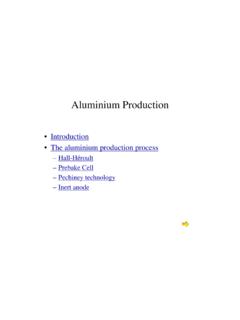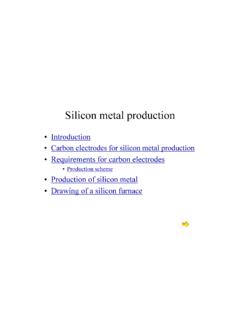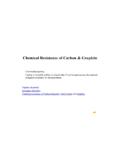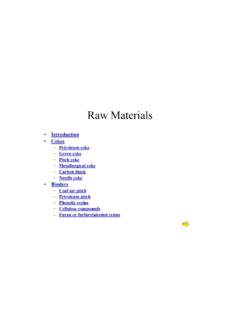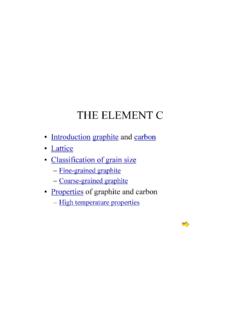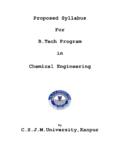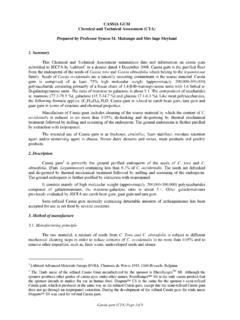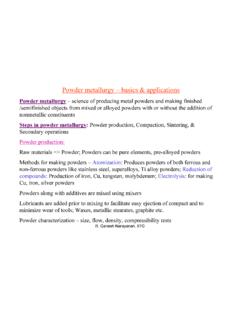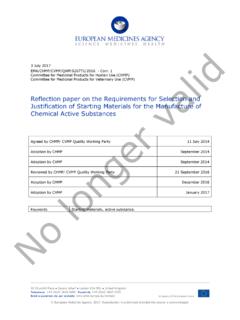Transcription of Graphite production further processing - Carbon …
1 Graphite production & further processingGraphite blocksGraphite production & further processing Introduction Graphitising Graphitisationfurnaces Coating Castner Inductively heatedfurnaces Purification Machining High grades surfacefinishing Coating Chemical vapourdepositionSome applications, such as Graphite electrodes for the electric arc furnace require a higher thermal and electrical conductivity than that of baked Carbon materials. These synthetic graphites normally follow a production process similar to that of baked Carbon (forming, impregnation, rebaking) but require an additional process step, that of graphitisationwhere temperatures of around 3000 C are achieved. Heat treatment -graphitisingThe final step in Graphite manufacture is a conversion of baked Carbon to Graphite , called graphitising, heat-treating the material at temperatures in the region of 2600 C 3300 C. During the graphitising process , the more or less pre-ordered Carbon (turbostratic Carbon ) is converted into a three-dimensionally ordered Graphite structure.
2 Depending on the raw materials and the processing parameters, various degreesof convergence to the ideal structure of a Graphite single crystal are achieved. Since graphitisation increases the lattice order and produces smaller layer distances, it simultaneously leads to a considerable growth of ordered domains. However, the degree of order that can be reached depends largely on the crystalline pre-order of the solid used. These reduced lattice layer distances are macroscopically noted as a contraction in volume. This graphitisation-shrinkage is approximately 3 to 5%. Due to this shrinkage, density of the Graphite processGeneral: The Graphitisation process Thefinal stepin the productionof Graphite is the graphitisation process . Amorphous or baked Carbon is convertedto electrographitebya thermal treatmentat approximately3000 C. Essentially any amorphous carbonmaterial can be crystallitegrowth and ordering arelatent within the baked Carbon structure.
3 Under the influenceof temperature the crystallites growand rearrangein an ordered patternof stacked parallel transformation is accompained bya changein the physical propertiesof thematerial(See change during graphitisation). The greater the degree of crystallitegrowth during heatingup, the better the graphitability (gaphitization degree), which effects thefinal resistivity achieved. There isa variation amongdifferent needle cokes concerning the graphitability. The graphitisation degree dependson the structureof the basicmaterial (graphitability)and the applied graphitisation is determined byx-ray during getssofter and better electricaland thermal property changesPropertyIncreaseDecreaseResistivi tyXApparent densityXStrengthXCTEXP orosityXWeightXModulusof elasticityXThermal conductivityXChange in mechanical properties during graphitisationTypicalChange in electrical properties during graphitisationTypicalTypical expansion during graphitisation Room to final baking temperature: Apart from the thermal expansion no additional changes.
4 900 -1200 C:As the calcinationtemperature of the filler component is(1173 -1473 K) surpassed, the incipient graphitic structure commences slowly. Up to 1500 C -2000 C:Hydrogen and sulphur from the binder are evolved (puffing)(1773 -2273 K) and an irreversible volume expansionoccurs. 1800 C surpassed:The graphitic structure proceeds more rapidly and(2073 K)increases beyond 2200 C. Up to 2600 C:A volume contraction takes place and crystallite growth(2873 K)predominates. 3000 C:Thermal and electrical conductivity reach the optimum.(3273 K)Developmentof crystallite alignment during graphitisation change by pictureHarry Marsch Heat treatment Graphitisation-AchesonAcheson furnaceThe stock is arranged in blocks within a horizontal bed, usuallyperpendicular to the axis of the furnace (click here for the pictureof the Acheson furnace). The space between these segments is filled with a resistor material consisting of a coke/ Graphite granular mixture.
5 The current is supplied to the load by two water-cooled head electrodes at the narrow sides of the furnace, whichis thermally insulated by a mixture of coke, sand, Carbon black and/or sawdust, thus protecting the material against oxidation. As the electrical resistance of the furnace decreases with an increasing degree of graphitisation, the power to the head electrodes is controlled and adjusted by transformers. Nowadays, nearly all graphitising furnaces are DC-operated since powerful rectifiers are available. For fine-grained material, an uncontrolled release of decomposition products from the charge does not cause problems, so that the normal maximum temperature of 2800 C can be reached within a few days. Depending on the size of the furnace and its operation mode, one working cycle including cooling lasts two to three weeks. Comparison withArchesonfurnaceAcheson furnaceHeat treatment -GraphitisationCastner furnace/longitudinal graphitisationLengthwise graphitisation (longitudinal array) was first described by Castner, and is characterised by the direct connection of the stock one to another in a row without a resistor material in between (click here for the pictureof the Castner furnace).
6 Theartifactsare clamped between the head electrodes of the furnace and heated by passing the current directly through the load. The contact area of the material to be graphitised has to fit well and therefore requires plane-parallel machining and an adjustable clamping device in order to secure a constant, tight electrical contact for a low-contact resistance. The insulation against oxidation and high heat losses is the same asfor Acheson furnaces. This graphitising method has the advantage of shorter heating periods, less power consumption and smaller furnace dimensions. Comparison withArchesonfurnaceLengthWiseGrapitisati on(Castner) furnaceLWG vs. AchesonAdvantages of the LWG over the Acheson furnace: Lower energy Reduced cycle time Better control of process for electrodeProduction Inductively heatedInductively heated furnacesInductively heated furnaces are normally used for parts, which need to be graphitised with a very well controlled temperature profile.
7 Indirectly heated furnaces consist of a horizontal or vertical Graphite tube of rectangular or cylindrical cross-section. The outside of these tubes is insulated with Carbon black surrounded by a Carbon felt jacket. The material is passed through the furnace, either continuously or at intervals. It is protected from oxidation by using water-cooled seals at the ends of the furnace and by applying a stream of inert gas. The main advantage of such furnaces is veryclose temperature control. production -purificationPurification of Graphite The graphitisingprocess is also accompanied by a purification of the material treated, normally reducing the content of impurities to considerably lessthan 1000ppm. For many applications, this purity is insufficient, so that a thermal purification at higher temperatures up to 3100 C with longer residence times is carried out to reduce the impurities to a concentration of less than 200ppm.
8 If still lower ash values are required, a thermo-chemical purificationis necessary. production -purificationThermo-chemical purificationEven after graphitisation at around 3000 C mostgraphitescontain small amounts of metallic impurities. If the ash values in the material have to be below 200ppm, thermal purification is applied. By adding gaseous halogens or halogen compounds, all hetero-atoms forming stable carbides are transferred into volatile halogen compounds and thus removed. By means of this procedure, impurities may be lowered to less than -machiningMachining graphiteGraphite can be machined wet or dry with ordinary machine tools but is normally machined dry. The different steps are dust extraction, cutting, turning, grinding, bondingand polishing. Click herefor safety recommendations when machining -dustDust extractionIndividual extraction arrangements are essential on all machineswhen dry machining is carried out.
9 Centralised extraction equipment is not worth installing except in large Graphite machine shops. Where workshops are predominantly engaged in metal machining it is enough to install industrial vacuum cleaners on individual machines (vacuum 300mm head of water or air velocity of about 18 m/sec).When machining Carbon and Graphite it is important to prevent ingress of dust into electrical motors and control -cuttingCuttingCutting of Graphite does not necessarily require specialist tools. However optimum results may be achieved using diamond cutting -drillingDrillingFor drilling Graphite , hard metal drills are used. To avoid chipping at the drilling exit the point angle should be 70-100 and the clearance angle 10-15 .Fabrication -turningTurningSpecialist machine tools for the turning of Graphite are not absolutely necessary and a wide range of machines are in use, from wood turning lathes to CNC lathes.
10 The machines normally have to be adapted to accommodate Graphite machining, in particular protection of electrical equipment from -rougheningRougheningThe surface of the Graphite is made rough by silicon carbide wheels with a grain size of 20-46 m and hardness F-K depending, on the hardness of the Carbon material. Fabrication -millingMillingSpecialised milling machines are not required but optimum results may be obtained using hard metal or diamond -finishingSuperfinishingDepending on the hardness of the Graphite material electro-corundum wheels with grain size 120-160 m and hardness P-Z are -bondingBondingIt is possible to bond Graphite ; for this process all surfaces must be free of dust and grease. Bonding materials are polyesters,phenolicresins, epoxy resins and silicon resins. For high temperature use, ceramic bonds are available using aluminium oxide or zirconium oxide as a milling and form grindingPreferred machining methods for the manufacture of Electric Discharge Machining (EDM) electrodes are milling and high-speed milling, form-grinding and EDM-cutting.
